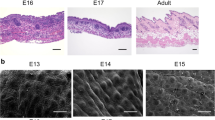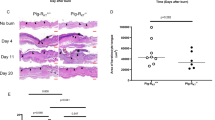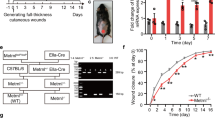Abstract
Fibronectin performs essential roles in embryonic development and is prominently expressed during tissue repair. Two forms of fibronectin have been identified: plasma fibronectin (pFn), which is expressed by hepatocytes and secreted in soluble form into plasma; and cellular fibronectin (cFn), an insoluble form expressed locally by fibroblasts and other cell types and deposited and assembled into the extracellular matrix. To investigate the role of pFn in vivo, we generated pFn-deficient adult mice using Cre-loxP conditional gene-knockout technology. Here we show that pFn-deficient mice show increased neuronal apoptosis and larger infarction areas following transient focal cerebral ischemia. However, pFn is dispensable for skin-wound healing and hemostasis.
This is a preview of subscription content, access via your institution
Access options
Subscribe to this journal
Receive 12 print issues and online access
$209.00 per year
only $17.42 per issue
Buy this article
- Purchase on Springer Link
- Instant access to full article PDF
Prices may be subject to local taxes which are calculated during checkout






Similar content being viewed by others

References
Schwartzbauer, J.E. Fibronectin: from gene to protein. Curr. Opin. Cell Biol. 3, 786–791 (1991).
Owens, M.R. & Climino, C.D. Synthesis of fibronectin by the isolated perfused rat liver. Blood 59, 1305–1309 (1982).
Hynes, R.O. Fibronectins. (Springer–Verlag, New York, 1990).
Mosher, D.F. Fibronectin (Academic Press, Inc., San Diego, California, 1989).
Giancotti, F.G. & Ruoslahti, E. Integrin signaling. Science 285, 1028–1032 (1999).
Hynes, R.O. Integrins: versatility, modulation, and signaling in cell adhesion. Cell 69, 11–25 (1992).
Yamada, K.M. Fibronectin peptides in cell migration and wound repair. J. Clin. Invest. 105, 1507–1509 (2000).
Clark, R.A.F. Fibronectin matrix deposition and fibronectin receptor expression in healing and normal skin. J. Invest. Dermatol. 94, 128S–134S (1990).
Singer, A.J. & Clark, R.A.F. Cutaneous wound healing. N. Engl. J. Med. 341, 738–746 (1999).
Clark, R.A.F. The Molecular and Cellular Biology of Wound Repair. (Plenum Press, New York, 1996).
Lipton, P. Ischemic cell death in brain neurons. Physiol. Rev. 79, 1432–1568 (1999).
Garcia, J. H. et al. Influx of leukocytes and platelets in an evolving brain infarct (Wistar rat). Am. J. Pathol. 144, 188–199 (1994).
Hamann, G.F., Okada, Y., Fitridge, R. & del Zoppo, G.J. Microvascular basal lamina antigens disappear during cerebral ischemia and reperfusion. Stroke 26, 2120–2126 (1995).
George, E.L., Georges-Labouesse, E.N., Patel-King, R.S., Rayburn, H. & Hynes, R.O. Defects of mesoderm, neural tube and vascular development in mouse embryos lacking fibronectin. Development 119, 1079–1091 (1993).
Kühn, R., Schwenk, F., Aguet, M. & Rajewsky, K. Inducible gene targeting in mice. Science 269, 1427–1429 (1995).
Deno, D.C., Saba, T.M. & Lewis, E.P. Kinetics of endogenously labeled plasma fibronectin: incorporation into tissues. Am. J. Physiol. 245, R564–R575 (1983).
Davie, E.W., Fujikawa, K. & Kisiel, W. The coagulation cascade: initiation, maintenance, and regulation. Biochemistry 30, 10363–10370 (1991).
Wilson, C.L. & Schwarzbauer, J.E. The alternatively spliced V region contributes to the differential incorporation of plasma and cellular fibronectin into fibrin clots. J. Cell Biol. 119, 923–933 (1992).
Corbett, S.A., Wilson, C.L. & Schwarzbauer, J.E. Changes in cell spreading and cytoskeletal organization are induced by adhesion to a fibronectin-fibrin matrix. Blood 88, 158–166 (1996).
Handagama, P.J., Shuman, M.A. & Bainton, D.F. Incorporation of intravenously injected albumin, immunoglobulin G, and fibrinogen in guinea pig megakaryocyte granules. J. Clin. Invest. 84, 73–82 (1989).
Harrison, P. et al. Uptake of plasma fibrinogen into platelet α granules of human megakaryocytes. J. Clin. Invest. 84, 1320–1324 (1989).
Wencel-Drake, J.D., Painter, R.G., Zimmerman, T.S. & Ginsberg, M.H. Ultrastructural localization of human platelet thrombospondin, fibrinogen, fibronectin, and von Willebrand factor in frozen thin section. Blood 65, 929–938 (1985).
Schick, P.K., Wojenski, C.M., Bennett, V.D. & Ivanova, T. The synthesis and localization of alternatively spliced fibronectin EIIIB in resting and thrombin-treated megakaryocytes. Blood 87, 1817–1823 (1996).
Pesciotta Peters, D.M., Portz, L.M., Fullenwider, J. & Mosher, D.F. Co-assembly of plasma fibronectin and cellular fibronectin into fibrils in human fibroblast cultures. J. Cell Biol. 111, 249–256 (1990).
Zhang, Z., Vuori, K., Reed, J.C. & Ruoslahti, E. The α5 β1 integrin supports survival of cells on fibronectin and up-regulates Bcl-2 expression. Proc. Natl. Acad. Sci. USA 92, 6161–6165 (1995).
Ni, H. et al. Persistence of platelet thrombus formation in arterioles of mice lacking both von Willebrand factor and fibrinogen. J. Clin. Invest. 106, 385–392 (2000).
Ffrench-Constant, C., Van De Water, L., Dvorak, H.F. & Hynes, R.O. Reappearance of an embryonic pattern of fibronectin splicing during wound healing in the adult rat. J. Cell Biol. 109, 903–914 (1989).
Brown, L.F. et al. Macrophages and fibroblasts express embryonic fibronectins during cutaneous wound healing. Am. J. Pathol. 142, 793–801 (1993).
Aoshiba, K., Rennard, S.I. & Spurzem, J.R. Cell-matrix and cell-cell interactions modulate apoptosis of bronchial epithelial cells. Am. J. Physiol. 271, L28–L37 (1997).
Globus, R.K. et al. Fibronectin is a survival factor for differentiated osteoblasts. J. Cell Sci. 111, 1385–1393 (1998).
de la Fuente, M.T., Casanova, B., Garcia-Gila, M., Silva, A. & Garcia-Pardo, A. Fibronectin interaction with α4β1 integrin prevents apoptosis in B cell chronic lymphocytic leukemia: correlation with Bcl-2 and Bax. Leukemia 13, 266–274 (1999).
Almeida, E.A.C. et al. Matrix survival signaling: from fibronectin via focal adhesion kinase to c-Jun NH2-terminal kinase. J. Cell Biol. 149, 741–754 (2000).
Martinou J.C. et al. Overexpression of BCL-2 in transgenic mice protects neurons from naturally occurring cell death and experimental ischemia. Neuron 13, 1017–1030 (1994).
Fässler, R. & Meyer, M. Consequence of lack of β1 integrin gene expression in mice. Genes Dev. 9, 1896–1908 (1995).
Potocnik, A.J., Brakebusch, C. & Fässler, R. Fetal and adult hematopoietic stem cells require beta1 integrin function for colonizing fetal liver, spleen, and bone marrow. Immunity 12, 653–663 (2000).
Forsberg, E. et al. Skin wounds and severed nerves heal normally in mice lacking tenascin-C. Proc. Natl. Acad. Sci. USA 93, 6594–6599 (1996).
Mullen, R.J., Buck, C.R. & Smith, A.M. NeuN, a neuronal specific nuclear protein in vertebrates. Development 116, 201–211 (1992).
Fässler, R. et al. Lack of β1 integrin gene in embryonic stem cells affects morphology, adhesion, and migration but not integration into the inner cell mass of blastocysts. J. Cell Biol. 128, 979–988 (1995).
Talts, J.F., Weller, A., Timpl, R., Ekblom, M. & Ekblom, P. Regulation of mesenchymal extracellular matrix protein synthesis by transforming growth factor-β and glucocorticoids in tumor stroma. J. Cell Sci. 108, 153–2162 (1995).
Aszodi, A. et al. The vasodilator-stimulated phosphoprotein (VASP) is involved in cGMP- and cAMP-mediated inhibition of agonist-induced platelet aggregation, but is dispensable for smooth muscle function. EMBO J. 18, 37–48 (1999).
Niwa, K. et al. Fibrinogen Mitaka II: a hereditary dysfibrinogen with defective thrombin binding caused by an Aα Glu-11 to Gly substitution. Blood 82, 3658–3663 (1993).
Rooney, M.M., Parise, L.V. & Lord, S.T. Dissecting clot retraction and platelet aggregation. J. Biol. Chem. 271, 8553–8555 (1996).
Kitagawa, K. et al. Cerebral ischemia after bilateral carotid artery occlusion and intraluminal suture occlusion in mice: evaluation of the patency of the posterior communicating artery. J. Cereb. Blood Flow Metab. 18, 570–579 (1998).
Schmid-Elsaesser, R., Zausinger, S., Hungerhuber, E., Baethmann, A. & Reulen, H-J. A critical reevaluation of the intraluminal thread model of focal cerebral ischemia. Evidence of inadvertent premature reperfusion and subarachnoid hemorrhage in rats by laser-doppler flowmetry. Stroke 29, 2162–2170 (1998).
Bederson, J.B. et al. Evaluation of 2,3,5-triphenyltetrazolium chloride as a stain for detection and quantification of experimental cerebral infarction in rats. Stroke 17, 1304–1308 (1986).
Acknowledgements
We thank W. Müller for providing Mx-Cre mice; J.F. Talts and K. Sekiguchi for mouse fibronectin cDNA; D.F. Mosher for human plasma fibronectin; E. Georges-Labouesse for antibody; and R. Timpl for discussions and critical reading of the manuscript. The work was supported by The Scandinavia-Japan Sasakawa Foundation (to T.S.), National Institute of Health grant CA47056 (to H.P.E), the Swedish Medical Research Council (K98-12X-12531-01A, to R.F.) and the SSF-Inflammation Program (to R.F.).
Author information
Authors and Affiliations
Corresponding author
Rights and permissions
About this article
Cite this article
Sakai, T., Johnson, K., Murozono, M. et al. Plasma fibronectin supports neuronal survival and reduces brain injury following transient focal cerebral ischemia but is not essential for skin-wound healing and hemostasis.. Nat Med 7, 324–330 (2001). https://doi.org/10.1038/85471
Received:
Accepted:
Issue Date:
DOI: https://doi.org/10.1038/85471
This article is cited by
-
Fibronectin fragments generated by pancreatic trypsin act as endogenous inhibitors of pancreatic tumor growth
Journal of Experimental & Clinical Cancer Research (2023)
-
Differential Regulation of Neurite Outgrowth and Growth Cone Morphology by 3D Fibronectin and Fibronectin-Collagen Extracellular Matrices
Molecular Neurobiology (2022)
-
Suppression of the fibrotic encapsulation of silicone implants by inhibiting the mechanical activation of pro-fibrotic TGF-β
Nature Biomedical Engineering (2021)
-
Thermosensitive collagen/fibrinogen gels loaded with decorin suppress lesion site cavitation and promote functional recovery after spinal cord injury
Scientific Reports (2021)
-
Microglia-organized scar-free spinal cord repair in neonatal mice
Nature (2020)


